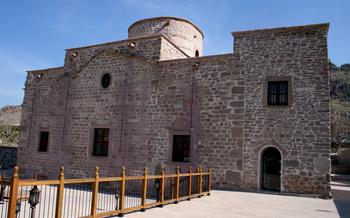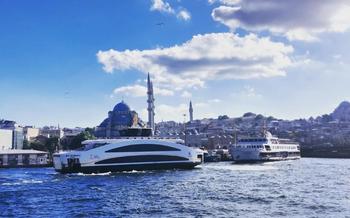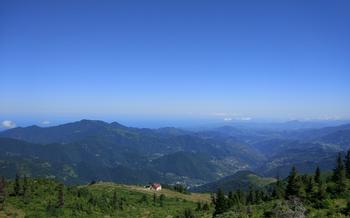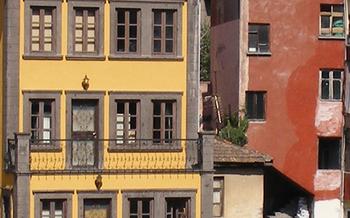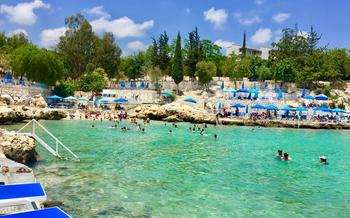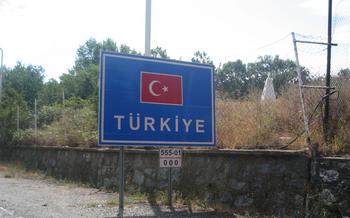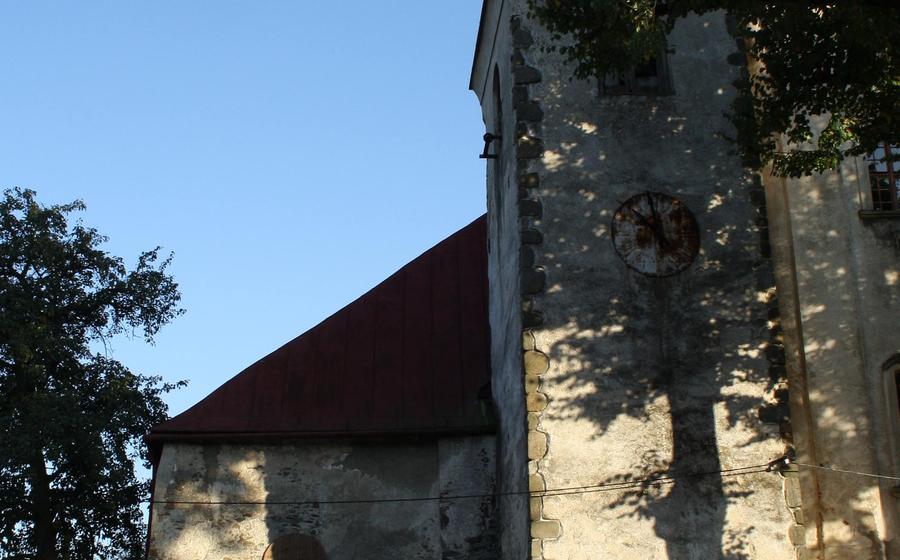
Küçük Ayvasıl Church
- History of the Küçük Ayvasıl Church
- Location and Accessibility
- Architectural Design
- Religious Significance
- Cultural Importance
- UNESCO World Heritage Status
- Visiting Hours and Admission
- Things to See and Do
- Dress Code and Etiquette
- Accessibility for Individuals with Disabilities:
- Photography and Social Media:
- Local Cuisine and Dining Options
- Souvenirs and Shopping
- Insider Tip: A Hidden Gem Unveiled
History of the Küçük Ayvasıl Church
The Küçük Ayvasıl Church, also known as the Church of the Holy Mother of God, holds a significant place in the history of Christianity and the cultural heritage of Trabzon. Built in the 13th century during the Byzantine Empire, the church showcases a blend of architectural influences reflecting the region's rich past. Its construction is attributed to Emperor Manuel I Komnenos, who dedicated it to the Virgin Mary.
Over the centuries, the church has undergone various transformations and renovations, adapting to the changing political and religious landscapes. In the 15th century, when Trabzon fell under Ottoman rule, the church was converted into a mosque, known as the Küçük Ayvasıl Mosque. Despite this conversion, the church retained many of its original Byzantine features, including the stunning frescoes and mosaics that adorn its interior.
In the 19th century, the church was restored to its original function as a Christian place of worship. Extensive restoration efforts were undertaken to preserve its architectural integrity and return it to its former glory. Today, the Küçük Ayvasıl Church stands as a testament to the region's diverse history, showcasing the harmonious coexistence of different cultures and religions.
Location and Accessibility
The Küçük Ayvasıl Church is nestled in the serene neighborhood of Boztepe, Trabzon, Turkey. It is conveniently located just 5 kilometers away from the vibrant city center, offering easy access for visitors to explore this historic gem. The church is situated on a hilltop, providing breathtaking panoramic views of the surrounding landscapes, including the azure waters of the Black Sea and the lush greenery of the Pontic Mountains.
Transportation options to reach the church are diverse and convenient. Local buses and taxis are readily available, providing affordable and comfortable rides from the city center. For those seeking a more immersive experience, guided tours are offered by local agencies, ensuring a comprehensive understanding of the church's history and significance. Alternatively, visitors can opt for the freedom and flexibility of renting a car, allowing them to explore the church at their own pace and venture into other nearby attractions.
The church is easily accessible for individuals with disabilities. Ramps and designated parking spaces are available to ensure a seamless visit for all. The church staff is also accommodating and willing to provide assistance to those in need, making the experience inclusive and enjoyable for everyone.
Architectural Design
The Küçük Ayvasıl Church stands as a testament to the harmonious blend of Byzantine and Ottoman architectural influences. Its exterior boasts a striking combination of stone and brick masonry, showcasing the intricate craftsmanship of the era. The church's most distinctive feature is its octagonal dome, a symbol of Byzantine architectural prowess, which crowns the central nave and exudes an aura of grandeur.
Inside, the church's layout follows the traditional Byzantine cruciform plan, with a nave, transepts, and an apse. The nave, the main body of the church, is supported by massive pillars, creating a sense of height and spaciousness. The dome, resting on pendentives, floods the interior with natural light, illuminating the intricate frescoes and mosaics that adorn the walls and ceiling.
The apse, the sacred sanctuary of the church, is adorned with a stunning mosaic depicting the Virgin Mary and Child, a testament to the skilled artistry of the Byzantine craftsmen. The mosaics, with their vibrant colors and lifelike expressions, narrate biblical stories and depict religious figures, adding to the spiritual ambiance of the church.
Religious Significance
Küçük Ayvasıl Church holds immense religious significance as a sacred place of worship for the Christian community. Throughout history, it has played a pivotal role in the spread of Christianity in the region, serving as a sanctuary for believers to gather, pray, and celebrate their faith.
Connection to the Greek Orthodox Community The church is closely associated with the Greek Orthodox community, which has a strong presence in Trabzon. For centuries, Greek Orthodox Christians have flocked to this sacred site to participate in religious ceremonies, observe holy days, and seek spiritual guidance. The church's interior is adorned with intricate iconography and artwork depicting scenes from the Bible, serving as a visual testament to the deep faith and devotion of the Orthodox believers.
Current Use for Religious Services and Ceremonies Even today, Küçük Ayvasıl Church remains an active place of worship for the local Christian community. Regular religious services, including Sunday mass, baptisms, and weddings, are held within its hallowed walls. During these sacred occasions, the church comes alive with the sound of prayers, hymns, and the gentle flicker of candles, creating an atmosphere of reverence and spirituality.
Cultural Importance
The Küçük Ayvasıl Church stands as a symbol of cultural heritage and identity for the local community. Its intricate architecture, stunning frescoes, and historical significance make it a cherished landmark in Trabzon. The church represents the rich cultural diversity of the region, where different ethnicities and religions have coexisted for centuries. It serves as a reminder of the shared history and cultural exchange that have shaped the unique identity of Trabzon.
The church's cultural importance extends beyond its religious significance. It is a symbol of resilience and continuity, having survived various historical events and changes in political power. Today, the church plays a crucial role in promoting cultural understanding and interfaith dialogue. It attracts visitors from all over the world who come to appreciate its beauty, history, and cultural significance. Efforts are ongoing to preserve and protect the church's cultural heritage, ensuring that it remains a source of pride and inspiration for generations to come.
UNESCO World Heritage Status
The Küçük Ayvasıl Church holds the prestigious distinction of being inscribed as a UNESCO World Heritage Site. This esteemed recognition highlights the church's outstanding universal value, meeting stringent criteria set by the United Nations Educational, Scientific and Cultural Organization (UNESCO). The church's exceptional architectural design, intricate artwork, and profound religious significance contribute to its global importance. As a World Heritage Site, the Küçük Ayvasıl Church is not only a national treasure but also a symbol of cultural heritage that transcends borders, fostering appreciation and understanding among people worldwide. This designation reinforces the church's significance, ensuring its preservation and protection for future generations to admire and cherish.
Visiting Hours and Admission
The Küçük Ayvasıl Church welcomes visitors with open arms, inviting them to explore its rich history and stunning architecture. To ensure a fulfilling experience, it's essential to be aware of the church's visiting hours and admission procedures.
The church is open to the public every day of the week, except for Mondays, allowing visitors to immerse themselves in its serene atmosphere at their convenience. During the summer months, from April to October, the church's doors are open from 9:00 am to 7:00 pm, providing ample time to explore its intricate details and soak in its spiritual ambiance.
In the winter season, from November to March, the church maintains slightly shorter visiting hours, opening from 9:00 am to 5:00 pm. This adjustment ensures that visitors can still enjoy their visit while considering the shorter daylight hours.
Admission to the Küçük Ayvasıl Church is free of charge, allowing everyone to experience its beauty and significance without financial barriers. This gesture reflects the church's commitment to sharing its cultural and religious heritage with visitors from all walks of life.
To enhance the visitor experience, guided tours are available upon request. Led by knowledgeable guides, these tours provide in-depth insights into the church's history, architecture, and religious significance, ensuring that visitors gain a deeper understanding of this remarkable site.
For those who prefer a self-guided exploration, the church offers informative brochures and signage that guide visitors through its various features and highlights. Audio guides are also available in multiple languages for a more immersive experience.
To avoid crowds and fully appreciate the church's tranquility, it's recommended to visit during the early morning or late afternoon hours. This allows visitors to take their time exploring the interior, capturing stunning photographs, and contemplating the church's spiritual essence without distractions.
Things to See and Do
Inside the Küçük Ayvasıl Church, visitors can marvel at the intricate frescoes and mosaics that adorn the walls and ceilings. The artwork depicts scenes from the Bible, including the life of Jesus Christ, the Virgin Mary, and various saints. The vibrant colors and lifelike details of the artwork create an awe-inspiring atmosphere that transports visitors back in time.
In addition to the stunning interior decorations, visitors can also explore the surrounding grounds of the church. The well-manicured gardens offer a peaceful oasis where visitors can relax and reflect. There are also several benches and seating areas where visitors can sit and take in the beauty of the church and its surroundings.
For those interested in photography, the Küçük Ayvasıl Church provides ample opportunities to capture stunning images. The unique architectural features, intricate artwork, and picturesque surroundings make for a photographer's paradise. Visitors are encouraged to bring their cameras and capture the beauty of this historic landmark.
Beyond the church itself, visitors can also explore the vicinity and discover other attractions in the area. The nearby Sümela Monastery, another UNESCO World Heritage Site, is a popular destination for its stunning architecture and breathtaking views. Visitors can also explore the vibrant city of Trabzon, with its bustling markets, historic landmarks, and delicious cuisine.
Dress Code and Etiquette
When visiting the Küçük Ayvasıl Church, it is essential to dress respectfully, adhering to the norms of a religious site. Modest attire is expected, with shoulders and knees covered. Revealing clothing, such as shorts, tank tops, or low-cut blouses, is discouraged. Visitors should avoid wearing clothing with offensive or inappropriate slogans or images.
Maintaining a contemplative atmosphere is crucial during your visit. Silence is observed inside the church, allowing visitors to reflect and connect with the sacred space. Avoid loud conversations, laughter, or disruptive behavior that may disturb other visitors or worshippers.
When taking photographs, be mindful of the privacy of other visitors and avoid using flash photography or tripods, which can be distracting or disruptive. If you wish to share your photos or videos on social media, do so respectfully, without capturing individuals without their consent or making disparaging remarks about the church or its significance.
Accessibility for Individuals with Disabilities:
The Küçük Ayvasıl Church is committed to providing an accessible and inclusive environment for visitors of all abilities. The church features several accessibility features to ensure that everyone can enjoy and appreciate its historical and cultural significance.
Designated parking spaces for individuals with disabilities are available near the church entrance, making it easy for visitors to arrive and depart conveniently. Ramps and elevators have been installed throughout the church, allowing wheelchair users and individuals with limited mobility to navigate the interior spaces seamlessly. Accessible restrooms are also available within the church premises.
In addition to physical accessibility, the church staff is trained to assist visitors with disabilities. They can provide wheelchairs or other assistive devices upon request and offer guidance or directions to ensure a smooth and enjoyable visit. Visitors with hearing impairments can request assistive listening devices to enhance their participation in guided tours or religious services.
The church's commitment to accessibility extends to its online presence as well. The official website offers accessibility features such as screen readers and alternative text descriptions for images, making it easier for visitors with visual impairments to access information about the church and plan their visit.
By providing these accessibility features, the Küçük Ayvasıl Church ensures that everyone, regardless of their abilities, can experience the beauty, history, and spiritual significance of this remarkable religious monument.
Photography and Social Media:
When visiting the Küçük Ayvasıl Church, it is important to be respectful of the sacred nature of the site. Photography is permitted, but flash photography and the use of tripods are not allowed. This is to ensure that other visitors are not disturbed by bright lights or obstructed views. It is also important to be mindful of the privacy of other visitors and to avoid taking photographs that may be intrusive or disrespectful.
When sharing photos and videos on social media, it is important to be mindful of the church's religious significance. Avoid using offensive or inappropriate language or imagery. It is also important to credit the church and to tag it in your posts so that others can learn more about this historic site. By following these guidelines, you can help to ensure that everyone has a positive and respectful experience when visiting the Küçük Ayvasıl Church.
Local Cuisine and Dining Options
After exploring the Küçük Ayvasıl Church, indulge in the culinary delights of Trabzon. The city's diverse cuisine reflects its rich cultural heritage, offering a tantalizing array of flavors and aromas to satisfy every palate.
For a taste of traditional Turkish cuisine, head to one of the many local restaurants or eateries near the church. Savor the succulent kebabs, grilled to perfection and infused with aromatic spices. Don't miss the gözleme, a savory flatbread stuffed with various fillings like cheese, spinach, or minced meat.
Vegetarians will find plenty of options to delight their taste buds. Try the dolma, a delicious dish of stuffed vegetables like bell peppers, tomatoes, or zucchini. The meze platters, featuring an assortment of small dishes like hummus, baba ghanoush, and ezme, are perfect for sharing and sampling a variety of flavors.
To satisfy your sweet cravings, indulge in the künefe, a heavenly dessert made with shredded filo dough, cheese, and syrup. Baklava, another must-try treat, is a flaky pastry filled with nuts and sweetened with honey.
For those seeking a panoramic view of the church while enjoying their meal, opt for a restaurant with an outdoor terrace or rooftop seating. As you relish the delectable cuisine, let the beauty of the Küçük Ayvasıl Church serve as a backdrop for your memorable dining experience.
Souvenirs and Shopping
Availability of Souvenirs and Handicrafts:
- Visitors can find a range of souvenirs and religious artifacts at shops or stalls near the Küçük Ayvasıl Church.
- These items often include icons, candles, crosses, and other religious objects.
- Additionally, there are handcrafted items such as pottery, textiles, and jewelry inspired by the church's history and culture.
Supporting Local Artisans and Businesses:
- By purchasing souvenirs from local artisans and businesses, visitors can contribute to the preservation of traditional crafts and support the local economy.
- Many of these items are handmade with love and care, making them unique and meaningful mementos of your visit.
Tips for Bargaining and Finding Unique Items:
- Bargaining is a common practice in Turkey, and visitors can often find good deals on souvenirs.
- It's important to be respectful and friendly when negotiating prices.
- Be sure to look around and compare prices at different shops before making a purchase.
- Don't be afraid to ask about discounts or special offers.
Unique Photo Opportunities:
- The Küçük Ayvasıl Church offers many unique photo opportunities for visitors.
- Capture the intricate details of the frescoes and mosaics, or take a panoramic shot of the church's exterior against the stunning backdrop of the surrounding mountains.
- Be creative and experiment with different angles and perspectives to capture the essence of this historic site.
Insider Tip: A Hidden Gem Unveiled
As you explore the Küçük Ayvasıl Church, keep an eye out for a hidden gem tucked away within its sacred walls. Behind a discreet door, you'll find a small chamber that once served as a secret passageway, connecting the church to a nearby monastery. This hidden corridor, now accessible to visitors, offers a unique glimpse into the church's rich history and its role as a refuge during times of persecution.
Don't miss the opportunity to step into this secret chamber and immerse yourself in the atmosphere of mystery and intrigue that surrounds it. Imagine the footsteps of monks and priests echoing through the narrow passageway as they sought refuge from danger. Let your mind wander back in time as you explore this hidden gem, adding an extra layer of fascination to your visit to the Küçük Ayvasıl Church.
